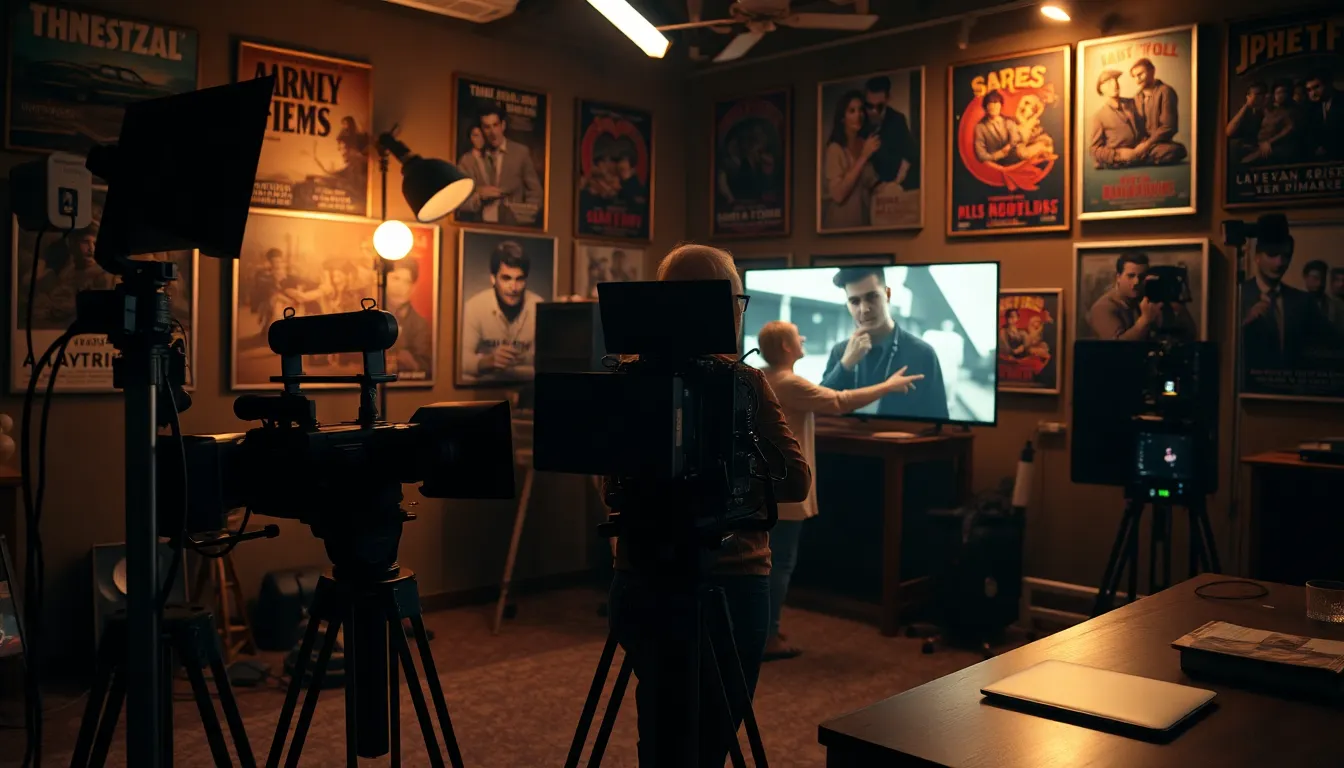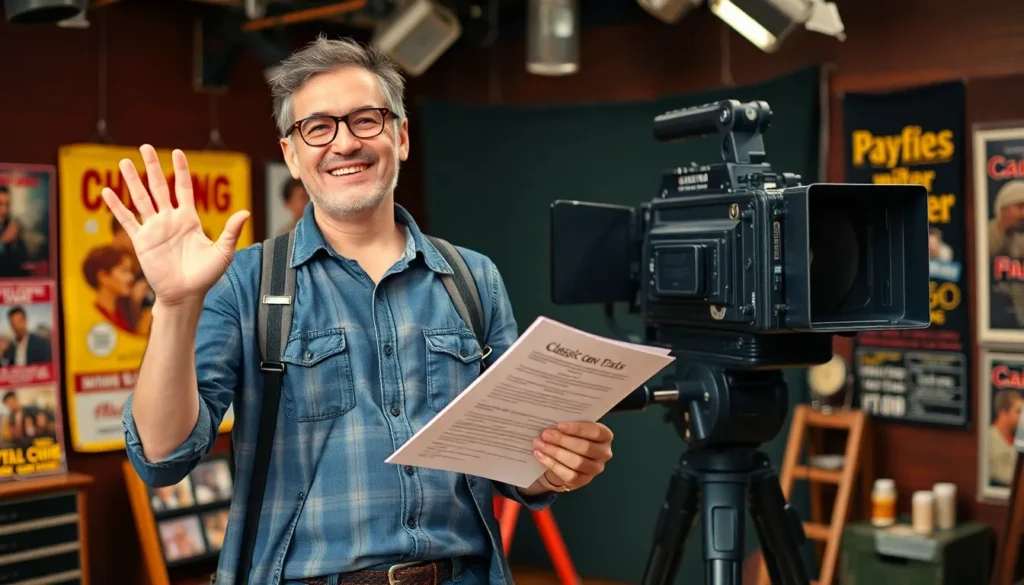Table of Contents
ToggleCinematic homage is like a filmmaker’s way of throwing a party for their favorite movies, complete with confetti made of nostalgia. Whether it’s a sly nod to a classic scene or a full-blown reenactment, these tributes breathe new life into beloved films while delighting audiences. It’s the ultimate form of flattery where directors pay respect to their influences, and viewers get to revel in the clever references.
Imagine watching a modern flick and suddenly spotting a familiar face or iconic line that whisks you back in time. That’s the magic of cinematic homage. It’s not just a clever trick; it’s a bridge connecting generations of movie lovers. So grab your popcorn and get ready to dive into the delightful world of cinematic homage, where every frame tells a story and every reference is a wink from the past.
Understanding Cinematic Homage
Cinematic homage celebrates influential films and directors through various references and tributes. These nods to the past resonate with audiences and enhance the viewing experience.
Definition of Cinematic Homage
Cinematic homage represents a filmmaker’s tribute to admired films or genres. It encompasses subtle acknowledgments or overt recreations, allowing filmmakers to express respect for their predecessors. Icons from earlier movies often reappear, fostering connection between past and present. Nostalgic elements, such as familiar scenes or dialogue, enhance storytelling while delighting viewers. This form of homage acts as a bridge, linking generations of film lovers, thus enriching the culture of cinema.
Historical Context
The roots of cinematic homage trace back to early cinema, where filmmakers paid tribute to their influences. Silent films often included nods to theatrical traditions, paving the way for future references. Notable directors like Alfred Hitchcock and Francois Truffaut embraced this practice, integrating their respect for earlier works into their films. As cinema evolved, homage became a vital part of storytelling. Contemporary filmmakers frequently draw from classics, demonstrating the enduring influence of iconic films on the current landscape. Significant tributes emerged in the 1970s and 1980s, establishing homage as an essential element in filmmaking.
Techniques Used in Cinematic Homage

Cinematic homage employs various techniques to evoke nostalgia and connect with audiences. Filmmakers harness visual and audio elements to create memorable experiences.
Visual References
Specific visual references play a crucial role in cinematic homage. Directors include iconic imagery from classic films, which instantly resonate with viewers. They may recreate famous scenes or use distinct cinematography styles, allowing audiences to recall beloved moments from the past. Subtle visual nods, such as a particular color palette, costume design, or framing technique, further enhance recognition. Such visual cues often serve as a bridge between generations, encouraging discussions about film history and inspiration.
Audio Cues
Audio cues significantly contribute to the effectiveness of cinematic homage. Recognizable soundtracks or motifs from earlier films evoke strong emotional responses. Filmmakers frequently incorporate reworked or sampled scores, inviting viewers to revisit familiar themes. Dialogue snippets or catchphrases can bring an additional layer of connection. When characters quote iconic lines, it creates a playful interaction with the audience, reinforcing the homage’s intent. These audio elements help celebrate the cinematic journey while engaging both longtime fans and new viewers.
Examples of Cinematic Homage
Cinematic homage appears throughout film history, with notable examples in both classic films and contemporary works. These instances showcase the profound influence of earlier cinema on modern storytelling.
Classic Films
Alfred Hitchcock’s Psycho pays homage to earlier horror films through its psychological thrills. The shower scene stands as one of cinema’s iconic moments, reflecting influences from German Expressionism. Similarly, Star Wars incorporates visual elements reminiscent of Flash Gordon, blending adventure with science fiction. Another classic, An American in Paris, draws inspiration from the vibrant atmosphere of French musicals. Each of these films connects audiences to their predecessors, creating a rich tapestry of cinematic history.
Contemporary Works
Modern filmmakers frequently draw from the past to create homages in their work. Quentin Tarantino’s Inglourious Basterds integrates references to war films, enhancing its narrative through nostalgia. Likewise, Stranger Things stands out for its tributes to 1980s pop culture, including homage to The Goonies and E.T.. Jordan Peele’s Get Out employs nods to horror classics, subtly influencing the genre’s future. These contemporary films invite discussions about their inspirations, bridging the gap between different generations of movie lovers.
Impact of Cinematic Homage
Cinematic homage significantly shapes contemporary filmmaking and audience experiences. Through its acknowledgment of past works, homage influences creative decisions and storytelling techniques.
Influence on Filmmaking
Innovative directors embrace homage to convey their artistic vision. Filmmakers often reference classic films or specific genres to enrich their narratives. Techniques such as visual callbacks or specific cinematographic styles enhance the authenticity of their tributes. Iconic motifs frequently appear in plotlines, establishing a dialogue between old and new cinema. By channeling their inspirations, directors craft films that resonate deeply with viewers. Successful examples include the stylistic choices visible in modern horror that hark back to earlier classics. Themes that emerge reflect cultural conversations, highlighting the ongoing evolution of storytelling.
Audience Reception
Audiences often respond positively to cinematic homage, fostering a shared experience among film lovers. Discovering references ignites nostalgia and encourages viewers to connect with their cinematic history. Familiar elements, such as lines or scenes, evoke emotional reactions, enhancing engagement with the film. The thrill of recognizing trademarks from beloved movies creates excitement. Each homage invites discussions about influences and film history, enriching viewer perspectives. Enhanced communication between generations occurs as younger audiences discover classic references. Cinematic homage transcends simple recognition, turning viewership into an interactive dialogue.
Cinematic homage serves as a powerful bridge between the past and present of filmmaking. By incorporating nostalgic references and visual callbacks, filmmakers not only pay tribute to their influences but also create a shared experience for audiences. This practice enriches storytelling and fosters connections across generations, allowing viewers to engage with cinema’s rich history.
As directors continue to explore this art form, they invite discussions about the films that shaped their creative journeys. Each homage not only celebrates iconic moments but also encourages a deeper appreciation for the craft of filmmaking. Embracing cinematic homage ensures that the legacy of classic films lives on, inspiring both filmmakers and audiences alike.







